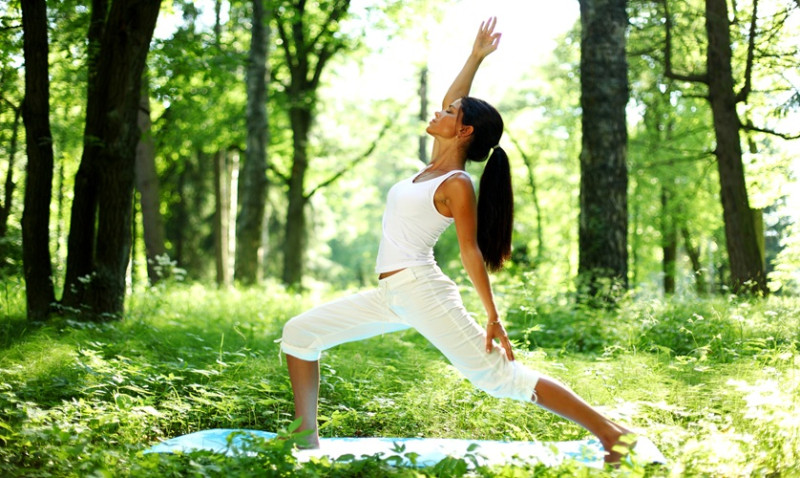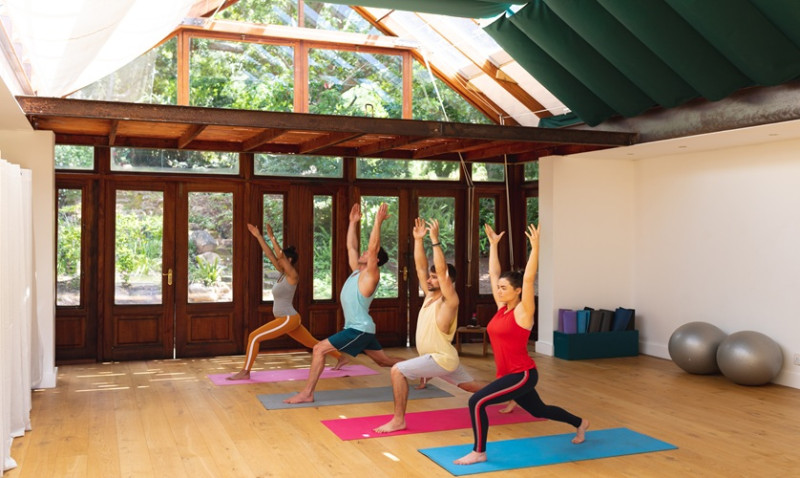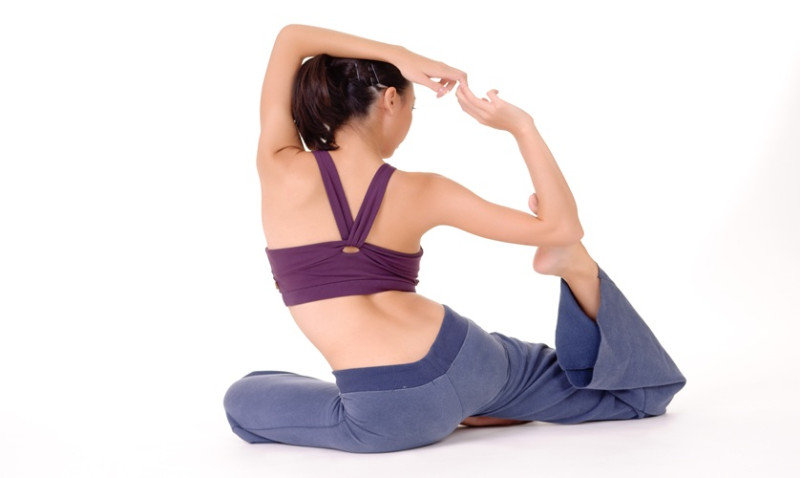
Yoga first entered my life as a quiet escape. Like many, I was juggling a demanding job, a bustling social life, and the consistent hum of London life. I started practicing yoga to find moments of stillness, but what I found was a transformative experience that slowly reshaped every part of my personal and professional life. My yoga mat became my sanctuary, and before long, I was dreaming bigger — of creating a sanctuary for others through my own yoga studio.
Initially, it was about self-care and stress relief. I’d book evening classes at local studios or squeeze in early morning sessions before work. Slowly, I became more engaged — experimenting with different styles like Hatha, Vinyasa, and Yin. I grew fascinated not just with the physical benefits, but also with the mental clarity and emotional resilience yoga offered.
I completed my yoga teacher training over the course of a year, attending intensive weekend classes and immersing myself in both the philosophy and the physiology of yoga practice. After qualifying, I began teaching community classes at church halls and local wellness events, honing my voice, sequencing skills, and understanding of what made yoga so special — connection.
What began as a personal practice organically evolved into a career path. Friends, coworkers, and even former clients started asking about private sessions. That quiet voice in the back of my mind that said, "One day, I want to open my own space," began to grow louder. And thus, the seeds of my own yoga studio were planted.
The Decision to Open My Own Yoga Studio
The decision to open my own studio wasn’t made lightly. Starting any business comes with risk, but wellness businesses in particular require balancing passion with profitability. I knew that just because I was passionate about yoga didn’t mean the venture would automatically succeed. It would take planning, patience, and research — especially in a competitive and diverse market like the UK.
One motivation was the lack of affordable, inclusive, and community-focused studios in my area. Most of the ones I visited had an intimidating vibe or catered to a specific, more advanced clientele. I wanted to create a studio that welcomed everyone — from busy professionals looking for a mid-day reset to tradesmen managing the physical demand of their day jobs, all the way to designers seeking mental clarity amidst creative deadlines.
I also saw a demand for flexible scheduling. With the increase in hybrid working environments, more people were looking for lunchtime or mid-afternoon classes. I began designing my future studio with that in mind — a calm, beautiful space that could adapt to the needs of both full-time professionals and self-employed individuals.
Finally, I wanted creative control. While teaching in other studios had been an enriching experience, it also came with limitations. From lighting and temperature settings to music playlists and class themes, I wanted to craft every element of the yoga experience to reflect my ethos of simplicity, authenticity, and connection.
Planning & Designing the Space
As someone deeply passionate about both wellness and interior design, curating the physical space of the yoga studio was one of the most exciting — and challenging — stages of the journey. I knew the space had to do three things: create calm, function beautifully, and embody sustainability wherever possible.
Location was essential. I looked for something central, walkable, and easy for my core demographic to access — think young professionals from offices, DIY creatives, local architects, and designers. Eventually, I found a hidden gem in a converted warehouse space near a popular high street. Plenty of natural light, high ceilings, and just enough character to transform into something unique.
When it came to the interior, I focused on natural materials and warm lighting. Cork flooring was chosen for its cushioning and eco-friendly footprint. Whitewashed walls reflect light and keep the space minimal but welcoming. Reclaimed wood paneling and woven textures added earthy depth without overpowering the serenity.
Storage was critical — props like blocks, bolsters, and mats needed to be kept tidy but accessible. I installed custom cabinetry behind bamboo screens, allowing for clean sightlines while maintaining ease of use. Good ventilation and acoustic panelling were installed to keep the atmosphere fresh and soundproofed — essential in shared commercial units.
For inspiration, I drew from Japanese minimalism and Scandinavian hygge — both known for their calming aesthetics and people-centric design. Every decision, right down to the scent diffusers and studio plants, supported a mission: to help patrons detox from modern life the moment they stepped inside.
Challenges Along the Way
Like many independent business owners, especially those in wellness, the journey wasn’t without its hurdles. The biggest challenge? Budget. Between leasing the space, renovating, purchasing high-quality equipment, and covering legal expenses, it’s easy for costs to escalate quickly. I tackled this by working with local tradesmen and suppliers, many of whom I met through family connections or recommendations from within my own yoga community.
Building regulations and permits were another surprising hurdle. Even seemingly minor structural changes required approval, and navigating UK planning permissions for wellness use required patience and persistence. For this, I worked closely with a local architect to ensure all safety, fire, and accessibility provisions were met — especially important for insurance and long-term sustainability.
Then, of course, were the moments of imposter syndrome. Was I ready? Would people come? What if the concept didn’t stand out? These doubts, while natural, were met with encouragement from others who had opened small businesses, proving that mindset can be as important as marketing.
Lastly, I had to navigate commercial insurance, creating membership models, developing policies, and building a digital presence. It became clear just how essential it was to wear many hats — teacher, designer, marketer, accountant, and community manager — when running a successful yoga studio in a competitive UK market.
Community First: Building Relationships, Not Just Revenue
One of the foundational principles of my studio is community over competition. From our opening day, I’ve emphasised connection — not only between teacher and student, but among the students themselves. We've hosted post-class herbal tea corners, artist showcases, and even yoga-for-tradespeople events to reflect the diversity of our community.
To support local designers and tradespeople, I featured on-site installations: light fixtures from a local ceramicist, yoga props crafted by a carpenter from Brighton, all helping showcase British craftsmanship in a subtle, meaningful way. This not only added story to the space, but encouraged word-of-mouth growth and collaboration between makers and designers.
I also created flexible membership plans for different lifestyles — from one-off class passes to monthly subscriptions and virtual-only access. Architects and interior designers whose project deadlines made regular class attendance tricky appreciated that flexibility.
We regularly host mindfulness and movement workshops tailored to workplace wellness. These events, geared toward young urban professionals, teach how to counteract the effects of extended desk time with simple at-home practices like seated twists, breathing exercises, and eye relaxation sequences.
The studio’s social media reflects this approach too — real, honest content showing everything from behind-the-scenes build-outs to teacher Q&As and style spotlight videos. It’s about being human, not just “on brand.” That transparency builds trust — and trust builds community.
Where We Are Now — And What’s Next
Today, my yoga studio is a vibrant hub for movement, breath, and connection. We’ve grown in both numbers and depth. In the past year, we’ve welcomed everyone from apprentice plumbers easing tight hips to fashion designers using meditation to enhance creative flow. The diversity in our community has made our classes more dynamic and our mission more powerful.
We’re currently piloting a lunchtime “Power Pause” series for local businesses — short, 30-minute yoga sessions designed to refresh during workdays. I’m also exploring partnerships with London architecture firms and co-working spaces to offer on-site yoga for staff well-being.
Looking ahead, I’m dreaming of expanding into retail — offering a curated shop of UK-made yoga accessories, essential oils, and soothing decor pieces. Eventually, I’d love to flip open a second micro-studio in another UK city known for its arts and design scene — possibly Bristol or Manchester.
Ultimately, opening this studio has been about more than yoga — it’s been about possibility. Transforming a simple idea into a place that holds people, connects them, and grows with them. If you’re dreaming of your own studio, know this: No matter your industry, you’re not just creating a space. You’re crafting an experience — and there’s never been a better time to begin.





